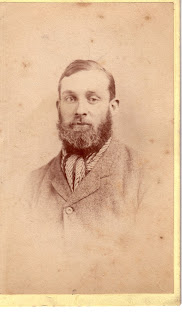
What tie is that? The ties in this photograph stood out for me, so that I really couldn't go past them. This ubiquitous fashion accessory of questionable symbolism has provided style, colour and emphasis when worn with the otherwise drab or plain attire generally favoured by men, and has taken many forms over the centuries. Here's an assortment of various tie styles and their wearers that I've found among my family history photo collection.. I've only found one showing braces, sorry to say, but no doubt they were keeping their trousers up, just hidden under their jackets. A few fob chains can be spotted there too.
These photos are believed to be of two young American gentlemen, Dan McGrew Calwell b.1830 and his brother Davis Calwell b. 1832, who emigrated from Pennsylvania to Melbourne Victoria in 1853 aboard the City of Norfolk, hoping to make their fortunes there in the Victorian goldfields around Ballarat, together with so many thousands of others who had been drawn by the prospect of great riches to be found there. In these formal photographs, possibly taken before the Calwell brothers left their home and family, never to return, they look to be wearing a type of the hand-tied bow tie style- essentially a ribbon tied into a bow. Davis Calwell married a Welsh girl in Melbourne and they produced twelve children, from one of whom my husband is descended, making him a 2x great grandson of Davis. Dan subsequently moved to New Zealand, where he remained a bachelor, despite his sartorial taste in ties (and hats).
My own paternal 2x great grandfather Adam Cruickshank was born in 1830, so was of the same vintage as Dan and Davis, but from a different corner of the world. The head shot below is extracted from a family group photograph taken on the occasion of his 50th wedding anniversary in 1906, and his bold wide tie looks to me to be tied Windsor style. He and his wife Charlotte emigrated from Turriff Aberdeenshire in 1863 to NZ and settled in the Gore district. The seven Cruickshank sons aren't following their father's lead, but instead are sporting a variety of tie styles, although the details are hard to see here as all but one appear white or pale in colour. My great grandfather Charles is standing second from left. In his own family portrait taken around the same time, he's wearing a different formal style, tied loose and low and possibly with a wing collar, but he still looks stylish, to me at least.


To compete the family album, below is a portrait of another great grandfather of mine, Thomas Alfred Byles with his family. My grandmother Myrtle, front left here, would later marry Oliver, who's standing next to his father Charles in the previous photograph. They were both aged around eleven at the date of the photographs, and young Oliver wasn't wearing a tie. Thomas's tie is not too clear but looks to be a patterned Windsor style.


 |
| In later life Ian often wore cravats, but in such a subtle, understated style that I had to search hard to find a picture of him wearing one. |
 |
| fancy knotting |
 |
| Is this chap in his continental cross style tie about to go deer-stalking? |
  A pair of stylish gents |
 |
| but I think this very thin style looks rather incongruous on this lady's husband |
 |
Generous Windsor knots, like that worn by
Adam Cruickshank, above
|

 |
| A stylish young Scotsman |
 |
| Western style |

and more continental cross style tie wearers
 |
| William's four sons, in a variety of collar and tie combinations. The eldest was only 13 when their father died of TB. |
 |
| William Forbes, 1838-1877, in Ascot style cravat |
 |


Doug Lind and his great grandfather Charles Young in smart bows, plus an unknown youngster from the Young family album, dressed up in his Sunday best.
Lastly, by way of dessert, here's a birthday creation that suits the topic, more or less: a carrot cake with cream cheese icing made by yours truly in 1989, back when they were all the rage :-)

That's it from me. Now go to Sepia Saturday and check out other people's interpretations on this week's topic.




































